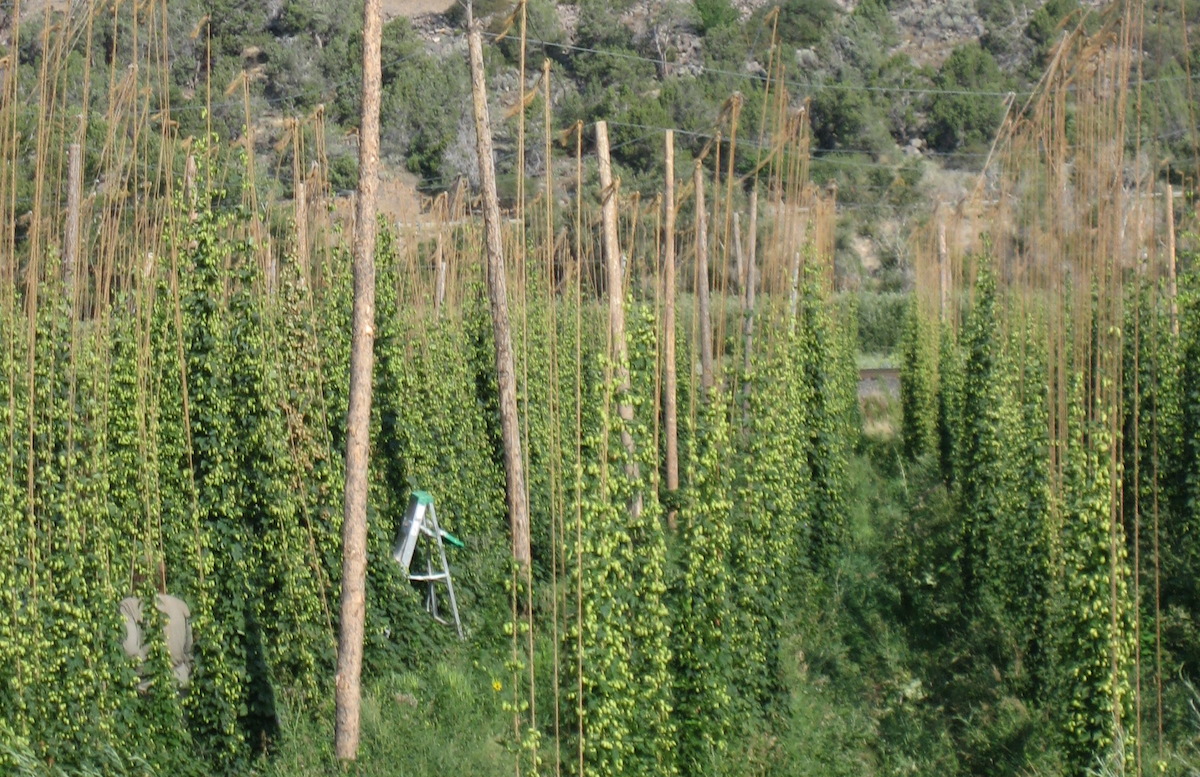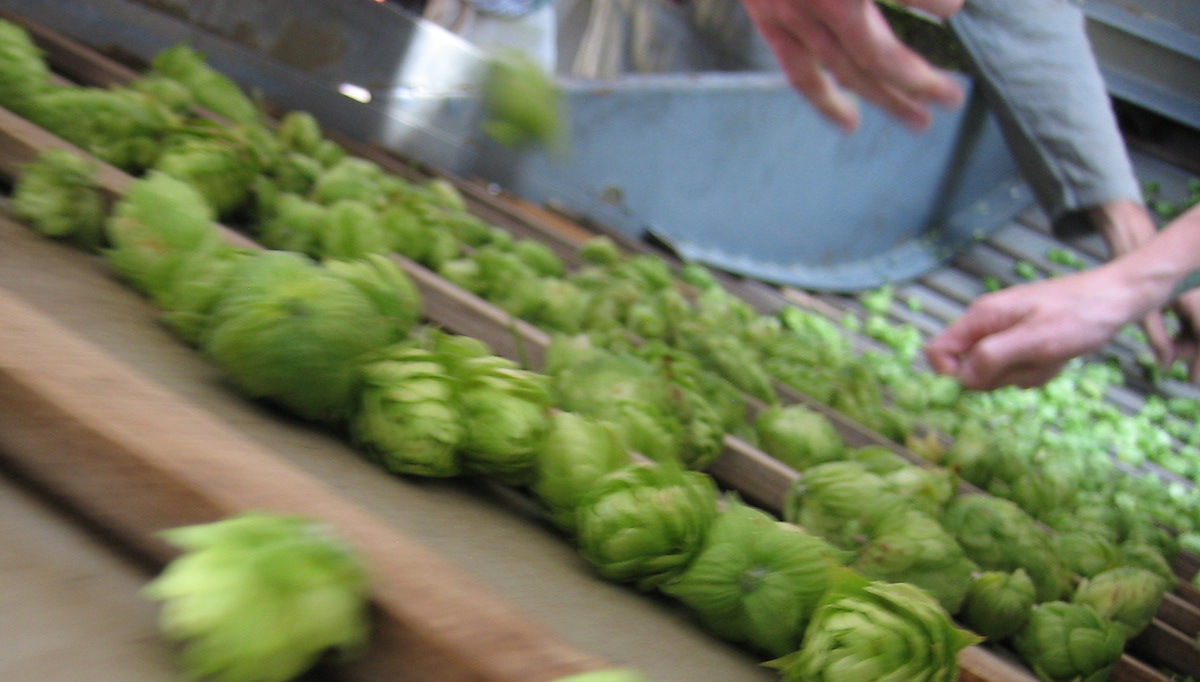The North Fork Valley Airport near Paonia, Colorado, has a single runway. This, itself, is a wholly unremarkable fact. Many airports do.
Rather more remarkable, however, is that this particular airport rests atop a 200-foot tall, 4,500-foot long mesa. As it happens, “forty-five hundred feet” also exactly describes the length of the airstrip. Thus, a pilot who deviates from the intended flight path either plunges, Thelma & Louise–style, right off the mesa or smashes headfirst into Delta County’s impressive but unforgiving geology.
Such were my thoughts last Tuesday as I watched a Cessna 180 accelerate down the runway, point its nose skyward, and successfully not fall off the mesa. Immediately thereafter, a Piper PA-24 Comanche executed the very same maneuver. And so it was that two volunteer pilots slipped the surly bonds of earth and began the vital airlift of more than 400 pounds of just-picked Cascades to Left Hand Brewing Company in Longmont, Colorado.
Left Hand brews its Warrior IPA once a year with fresh cones from Rising Sun Farms in Paonia and Still Wind Farm, a few miles to the west. After interviewing Left Hand’s Director of Operations, Joe Schiraldi, for a recent article (see “The Last Seasonal” in Issue 8 (August/September 2015) of Craft Beer & Brewing Magazine®), I accepted his kind invitation to join him for the 2015 harvest on Colorado’s western slope. Joe and his crew would need just over 1,000 pounds of fresh hops to brew 120 barrels of Warrior, and the window in which to harvest them is brief.

Hop farms vary in size from glorified backyard gardens to Anheuser-Busch’s 1,800 acre Elk Mountain Farm in Idaho. At nine acres, Rising Sun’s hop fields lie at the smaller-scale end of the spectrum, but the seemingly unending rows of hop trellises are no less impressive for it. Glen, the farm’s owner, manages a completely organic operation that, in addition to the hop fields, includes an apple orchard and a vegetable garden.
Beer is an agricultural product. And as much as we like to obsess over mash temperature, extract efficiency, and carbonation pressure, we’d be nowhere without malt and hops. And we’d really be nowhere without farmers. Growing hops is a business, of course, but it’s also a way of life.
The Harvest
When I arrive at 8:30 a.m., the crew, and a handful of representatives from Left Hand, are already hard at work.
“Time for another load,” Glen exclaims as he herds a group of us toward a flatbed trailer. Five workers and volunteers pile on, taking care to distribute ourselves fore and aft so as to avoid transforming the harvester into a sort of rustic seesaw. Glen floors the John Deere tractor that pulls us along, and after identifying a row of hops bines that look, feel, and smell ready, takes a hard left and pulls into the 7-foot wide empty space between two long, green cascades.
The hops plants grow up 18-foot ropes suspended from a horizontal trellis system. As Glen slowly drives us down the row, a machete-wielding farmhand frees one rope at a time near its upper anchor, then hands it to another worker so he can get to the next rope in the series. That other worker then flings the hop-laden rope toward the rear of the trailer, where several of us catch it and place it on the growing heap. Our job is to keep the pile of bines oriented in one direction so that they can more easily be harvested in a few minutes’ time.
It’s awkward work at first, and the bines’ sharp bristles, which have enabled these Cascades to snake their way skyward all summer, have now become scratchy weapons in a collective resistance movement. You can tell who has done this before by the long sleeves they wear. I, on the other hand, will go home with a few battle scars. But trust me when I say that a wound never smelled so sweet.

After successfully cleaning a row, we’re off to the hop picker, a Rube Goldberg-inspired contraption that separates the valuable cones from the now-useless bines and leaves. The machine’s German name, _Hopfenpflückmaschine, _is so unwieldy that everyone in the industry simply calls it a wolf picker, a nod to manufacturer WOLF Anlagen-Technik in Bavaria’s Hallertau region. Odell Brewing Company even named an experimental pale ale after it.
“Something almost always goes wrong with it,” says Tommy, the farm’s soft spoken mechanic, “But it’s been running smooth so far today.” Originally from Nashville, Tommy moved west to work on luxury condos, but changing circumstances landed him on the farm instead. Now he serves as Glen’s jack-of-all-trades and, in addition to keeping the wolf picker running, oversees irrigation, the trellises, and virtually every other aspect of the operation. I find myself feeling that it was the condo builder’s loss.

Tommy’s work is impeccable, and the wolf picker is very good at what it does. Workers feed bines, one at a time, into an inlet as mechanized hooks drag the bines into the machine. Inside, rows of spindly metal fingers mounted on rollers do the plucking that otherwise would have required a whole village. While the bines, leaves, and stems emerge from the back of the wolf picker (destination: compost bin), intact cones travel up a conveyor belt on the side, where workers carefully inspect the lot for anything that ought not be there.
One of the inspectors, Laura, has come to Paonia from St. Louis, working one harvest at a time until she reaches California. We chat about the hops field, and she tells me that much of Delta County’s apple crop, including Glen’s, was decimated by a late frost. Luckily, Glen’s diversified business includes not just hops and apples, but a whole set of services related to the import, maintenance, and re-selling of wolf pickers. In fact, 2015 will be the last year for this particular wolf picker at Rising Sun. Next year, they’ll have a larger model that can process twice as many hops per hour.
The hops fall off the conveyor and are funneled into burlap bags, which are taken to the on-site cold storage room and held until ready for use. Most hops end up in the adjacent drying room, from where they’ll be baled and sold as year-round commodities. But today’s harvest is all going straight to Left Hand’s brewhouse. About 400 pounds will fly from the mesa-top airstrip, while the remaining 600 or so will travel by van, arriving just as the first rounds of brewing wrap up. To surpass this level of freshness, Joe and his team would have to grow hops outside the brewery itself.
I ride with Joe to the airport and help load burlap bags of hops into the airplanes. The bags, which once held green coffee beans, all bear a “Product of Colombia” mark, and we joke about what the feds might think if they happened upon our little operation. Soon the planes are off, and the Cascades well on their way to a greater purpose.
Get to Know the People
I traveled to Paonia expecting to better understand the logistics of the harvest, and in this respect, the experience did not disappoint. But even more than the mechanics of it all, the people made an indelible impression. Whether it’s a limited release bourbon barrel-aged seasonal or a ubiquitous light lager, each and every sip of beer owes its existence to the cumulative efforts of farmers, seasonal workers, volunteers, and visionaries. We owe them a debt of gratitude.
Let’s ensure that “farm-to-table” remains more than just a trendy label inscribed upon menus and labels to justify charging a premium. I strongly encourage anyone who brews beer, sells beer, or drinks beer to make visiting a farm as high a priority as touring your favorite brewery. Go see where the hops grow. Go tour the barley fields. Chat with the farmers. Theirs is a way of life most of us know little about and one, I think, from which we could stand to learn quite a lot.

